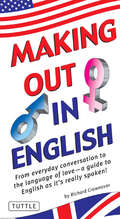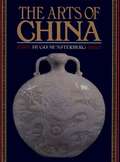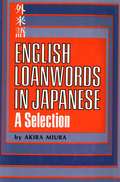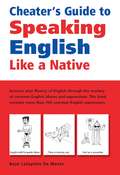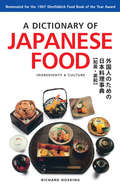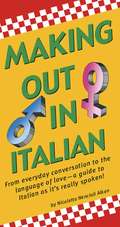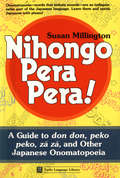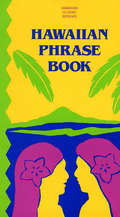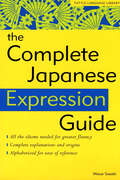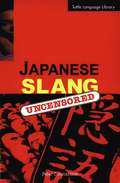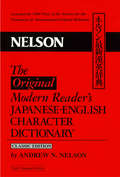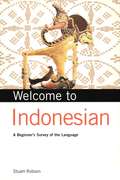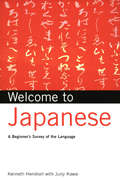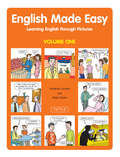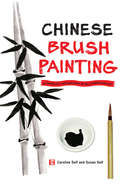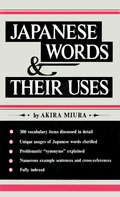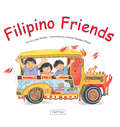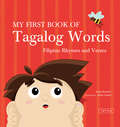- Table View
- List View
Making Out in English
by Richard CrownoverMaking Out in English is a fun, accessible and thorough English phrase book and guide to the English language as it's really spoken.If you are a student, businessman or tourist traveling to the English speaking world and would like to have an authentic and meaningful experience, the key is being able to speak like a local. This friendly and easy-to-use English phrasebook makes this possible. Making Out in English has been revised and redesigned to act as a guide to modern colloquial English for use in everyday informal interactions-giving access to the sort of catchy English expressions that aren't covered in traditional language materials. In the case of difficulties the book can be shown to the person the user is trying to communicate with.This English phrasebook includes:A guide to pronouncing English words correctlyExplanations of basic English grammarComplete translationsUseful and interesting notes on the English language and cultureLots of colorful, fun and useful expressions not covered in other phrasebooks
Making Out in English
by Richard CrownoverMaking Out in English is a fun, accessible and thorough English phrase book and guide to the English language as it's really spoken.If you are a student, businessman or tourist traveling to the English speaking world and would like to have an authentic and meaningful experience, the key is being able to speak like a local. This friendly and easy-to-use English phrasebook makes this possible. Making Out in English has been revised and redesigned to act as a guide to modern colloquial English for use in everyday informal interactions-giving access to the sort of catchy English expressions that aren't covered in traditional language materials. In the case of difficulties the book can be shown to the person the user is trying to communicate with.This English phrasebook includes:A guide to pronouncing English words correctlyExplanations of basic English grammarComplete translationsUseful and interesting notes on the English language and cultureLots of colorful, fun and useful expressions not covered in other phrasebooks
The Arts of China
by Hugo MunsterbergThe arts of China are products of the world's oldest continuous artistic tradition as well as one of its most brilliant. In this stimulating work, noted Oriental art authority Dr. Hugo Munsterberg traces the history of Chinese art dynasty by dynasty, elucidating the origins and development of major movements in painting, ceramics, bronzes, sculpture, and architecture. He clearly describes and defines the important trends and influences that culminated in the brilliant sculpture of the T'ang, the enchanting landscape paintings of the Sung, and the exquisite ceramics of the Ming. Outstanding examples of each genre are presented in over one hundred superb color and black-and-white photographs.
English Loanwords in Japanese
by Akira MiuraToriningu-pantsu are not training pants for babies who have not yet been toilet-trained. Toreningu-pantsu are sweat pants. When you jump into a swimming pool you will get wet, but not necessarily uetto. Volleyball, which was invented in the United States, is known as bareboru in Japan, but the tennis volley was the English gentleman's pride before it was America's . A tennis volley is therefore pronounced in British style, bore, not as American bare. Oru means "all" but has a more limited usage. Bosu is often used more negatively than English boss.Many people imagine that speakers of English who study the Japanese language find their way eased by the profusion of "English words" the Japanese have borrowed. Students of the language, however, often complain that borrowed words are more problematic than the older terms in the Japanese word pool.One of the biggest problems is the lack of adequate reference materials on the terms. Many of the existing works do little more than define the terms. This book handles the problematic areas. Here a reader will find sample sentences, tips on usage, and warnings against easy-to-commit mistakes. There are fascinating studies of how certain "English" terms were coined in Japan and of what led the Japanese to redefine certain common English words. Miura examines how certain words entered Japanese, and why they became popular.He theorizes on why an unexpected pronunciation developed. In discussing the borrowed terms, the author draws on many linguistic scholars, discusses prevailing beliefs on etymology and pronunciation, and uses his own considerable experience with both English and Japanese to help the student gain control of some of the most problematic words borrowed by J apanese from English . Each of the 850 words discussed under the text's more than 350 main headings is included in a n index for quick reference. The detail and currency of the explanations contained in this book are unmatched by other books on the subject. For the student hard put to use these borrowed words, this text offers real help.
Cheater's Guide to Speaking English Like a Native
by Boye Lafayette De MenteIncrease your fluency of English through the mastery of common English idioms and expressions.All Native English-speakers use a large number of proverbs and colloquial expressions in their daily conversations. These common sayings, which evolved over the centuries, are like "codes" that reveal the cultural values and attitudes of the speakers.To obtain complete fluency in the English language it is necessary to be familiar with these expressions and know how and when to use them.With a user-friendly format, The Cheater's Guide to Speaking English like a Native is a shortcut to achieving that goal.
A Dictionary of Japanese Food: Ingredients & Culture
by Richard HoskingNominated for the Glenfiddich Food Book of the Year Award, this timeless volume is the first and only book of its kind on the subject.<P><P>A Dictionary of Japanese Food helps food lovers around the world decipher the intricacies and nuances of Japanese cooking and its ingredients. Definitions in ordinary cookbooks and standard dictionaries--such as akebia for akebi, sea cucumber for namako, plum for ume--can be inadequate, misleading, or just plain wrong. Richard Hoskings eliminates the mystery by ensuring that each entry in the Japanese-English section includes the Japanese term in Roman script; the term in kana or kanji or both; a Latin name where appropriate; an English definition; and, for most entries, a short annotation.The English-Japanese section defines important English food terms in Japanese and annotates those needing explanation. One hundred small line drawings make it easy for readers to identify everything from mitsuba to the okoze fish, and seventeen appendices address the most critical elements of Japanese cuisine, from the making of miso and the structure of the Japanese meal to the tea ceremony.
Making Out In Italian: (Italian Phrasebook)
by Nicoletta Nencioli AikenMaking Out in Italian is a fun, accessible and thorough Italian phrase book and guide to the Italian language as it's really spoken.This friendly and easy-to-use Italian phrasebook makes this possible.<P><P> Making Out in Italian has been carefully designed to act as a guide to modern colloquial Italian for use in everyday informal interactions-giving access to the sort of catchy Italian expressions that aren't covered in traditional language materials. Each expression is given in Italian so that in the case of difficulties the book can be shown to the person the user is trying to communicate with. In addition, phonetic spellings of all words and phrases are included, making speaking Italian a breeze. For example, "Hi!"-ciao is also written as chah-oh.This Italian phrasebook includes:A guide to pronouncing Italian words correctly including double consonants and syllable stressesExplanations of basic Italian grammar, such as, questions, word gender, and formal vs. informalComplete Italian translations for all words and phrases including easy-to-use phonetic spellings.Useful and interesting notes on Italian language and cultureLots of colorful, fun and useful expressions not covered in other phrasebooks
Nihongo Pera Pera !
by Susan MillingtonOnomatopoeia-words such as "glug glug," "pow," and "splash" in English- are an integral part of Japanese. Japanese people draw on a wealth of onomatopoeiato express subtle feelings, images, sounds, and actions. With this book you too can become pera pera - fluent- in Japanese, speaking with clarity and flair.Four hundred entries covering everything from food to weather provide clear definitions and helpful example sentences. With an overview of the use andhistory of onomatopoeic expressions, Nihongo Pera Pera! offers a systematic and entertaining approach to learning an essential part of Japanese. Add these expressions to your vocabulary and dramatically improve your ability to express yourself. A must for both serious and casual learners, Nihongo Pera Pera!is your key to fluency.
Nihongo Pera Pera !
by Susan MillingtonOnomatopoeia-words such as "glug glug," "pow," and "splash" in English- are an integral part of Japanese. Japanese people draw on a wealth of onomatopoeiato express subtle feelings, images, sounds, and actions. With this book you too can become pera pera - fluent- in Japanese, speaking with clarity and flair.Four hundred entries covering everything from food to weather provide clear definitions and helpful example sentences. With an overview of the use andhistory of onomatopoeic expressions, Nihongo Pera Pera! offers a systematic and entertaining approach to learning an essential part of Japanese. Add these expressions to your vocabulary and dramatically improve your ability to express yourself. A must for both serious and casual learners, Nihongo Pera Pera!is your key to fluency.
Hawaiian Phrase Book
by Charles E. Tuttle Company, Inc.Originally, the primary object of this manual was to teach natives to converse in English. At the same time, the work is designed to assist strangers, speaking English, to acquire the correct colloquial speech of the Hawaiians.
The Complete Japanese Expression Guide
by Mizue SasakiA companion volume to The Complete Japanese Verb Guide andThe Complete Japanese Adjective Guide, with over 600 idioms.The Complete Japanese Expression Guide enables students to speak and understand idiomatic Japanese with the ease and fluency of a native speaker. For the first time ever, over 600 of the most commonly used idiomatic expressions in the Japanese language have been brought together and alphabetized in a single, convenient volume. No longer will the student have to rely on stuffy academic-sounding phrases and expressions. Mizue Sasaki has successfully taken stilted formality out of Japanese, and made natural, idiomatic communication readily possible. This handy volume not only introduces essential idioms, but also provides easy-to-understand translations and numerous example sentences to show how the expressions should be used. Studying colloquial Japanese doesn't have to be hitori-zumo, a futile effort (page 94). With The Complete Japanese Expression Guide, fluency is guaranteed.
Japanese Slang
by Peter ConstantineReveals, in vivid detail, the richness of Japanese slang in all its amusing, bizarre and shocking forms.
Japanese Slang
by Peter ConstantineReveals, in vivid detail, the richness of Japanese slang in all its amusing, bizarre and shocking forms.
The Original Modern Reader's Japanese-English Character Dictionary
by Andrew M. Nelson"The Japanese government may someday recognize-- as it ought to--Tuttle's contribution to creating an intelligent interest in Japan among the English-reading public, and deepening understanding of Japanese overseas."--Hokubei Mainichi (San Francisco)Awarded the 1969 Prize for the Society of the Promotion of International Cultural Relations, this is the most comprehensive Japanese book of its kind. Containing Japanese-English and English-Japanese sections, it is an essential reference tool for serious students studying the Japanese language or for business people and tourists wishing to learn Japanese before they travel.Special features include: Lists over 5,000 carefully selected characters with their 10,000+ current readings and almost 70,000 compounds in current use, al with concise English definitions. Scientifically arranged by a logical extension of the traditional radical system so as to make the finding of a given character almost fool-proof, saving hours of time. Makes provision for quickly finding characters either in their traditional or their modern and often greatly altered forms, thus serving for both prewar and postwar literature. Includes 14 valuable appendices giving (1) instructions for the most efficient use of the book, (2) discussions of the written language in general and particularly of its recent and far-reaching official modifications, and (3) much helpful
Welcome to Indonesian
by Stuart RobsonThis is a concise and user-friendly introduction to the Indonesian languageThis concise book aims to introduce the reader to the Indonesian language not by creating a course, with grammar and exercises, but by describing it from various points of view, such as telling what it is related to and how it has developed, and on this basis saying where some of its words originate, as a means of familiarization with some common examples. After that, the description moves on to talk about the kinds of words one wold expect to meet, and how they can be put together as sentences, before providing a few examples of journalistic prose as well as some more literary specimens, in order to give a feeling for the language. Welcome to Indonesian includes:Chapter 1: What is Indonesian?Chapter 2: Bahasa Indonesia as the National LanguageChapter 3: A Historical OverviewChapter 4: The Development of Modern IndonesianChapter 5: Indonesian and MalaysianChapter 6: The colloquial Dimension, Influence of Dialek JakartaChapter 7: What is Indonesian Related to?Chapter 9: Loanwords in Indonesian Chapter 10: The Indonesian WordChapter 11: The Indonesian SentenceChapter 12: Journalistic ProseChapter 13: A Literary DimensionSuggestions for Further ReadingGlossary of Indonesian Words
Welcome to Indonesian
by Stuart RobsonThis is a concise and user-friendly introduction to the Indonesian languageThis concise book aims to introduce the reader to the Indonesian language not by creating a course, with grammar and exercises, but by describing it from various points of view, such as telling what it is related to and how it has developed, and on this basis saying where some of its words originate, as a means of familiarization with some common examples. After that, the description moves on to talk about the kinds of words one wold expect to meet, and how they can be put together as sentences, before providing a few examples of journalistic prose as well as some more literary specimens, in order to give a feeling for the language. Welcome to Indonesian includes:Chapter 1: What is Indonesian?Chapter 2: Bahasa Indonesia as the National LanguageChapter 3: A Historical OverviewChapter 4: The Development of Modern IndonesianChapter 5: Indonesian and MalaysianChapter 6: The colloquial Dimension, Influence of Dialek JakartaChapter 7: What is Indonesian Related to?Chapter 9: Loanwords in Indonesian Chapter 10: The Indonesian WordChapter 11: The Indonesian SentenceChapter 12: Journalistic ProseChapter 13: A Literary DimensionSuggestions for Further ReadingGlossary of Indonesian Words
Welcome to Japanese: A Beginners Survey of the Language
by Junji Kawai Kenneth G. HenshallThis is a concise and user-friendly introduction to the Japanese language.<P><P>Japanese has too often been treated by Westerners as an exotic curiosity, but the reality is that it is a functional language spoken as a mother tongue by more than 125 million people, and ranks as the ninth most spoken language in the world. In the present global age, an age characterized by a vast range of Japanese products including electronic games and anime, more and more Westerners are in one way or another interacting with Japan and Japanese people. But it is nonetheless fair to say that the language, while increasing in popularity as a subject of study, is still not as widely spoken among non-Japanese as we might expect.In this book we would therefore like to "demistify" Japanese, to show how the language is formed and used, and to encourage you to pursue the study of it. Of course it has its challenges, especially with regards to the writing system, but we try to put these in a balanced context. And we like to think that, by describing the various facets of the Japanese language to you, we thereby empower you with a degree of knowledge and familiarity.
English Made Easy Volume One
by Jonathan Crichton Pieter KosterThis is a fun and user-friendly way to learn English English Made Easy is a breakthrough in English language learning-imaginatively exploiting how pictures and text can work together to create understanding and help learners learn more productively. It gives learners easy access to the vocabulary, grammar and functions of English as it is actually used in a comprehensive range of social situations. Self-guided students and classroom learners alike will be delighted by the way they are helped to progress easily from one unit to the next, using a combination of pictures and text to discover for themselves how English works. The pictorial method used in this book is based on a thorough understanding of language structure and how language is successfully learned.English Made Easy, Volume 1 consists of a total of 20 units arranged in groups of five. The first four units presents language and provide learners the opportunities to practice as they learn. The first page of each unit has a list of all the words and phrases to be learned in that unit, together with pronunciation guide. At the end of each unit, an interesting story which uses the language that has just been learned is presented
An Introduction to Japanese Kanji Calligraphy
by Bob Godin Takezaki KuniiThis step-by-step Japanese calligraphy book explains the systems of Japanese language and delves into details of written Japanese characters and techniques of kanji calligraphy.The word calligraphy literally means "beautiful writing." It is an art form that can be found in most civilizations with a written script. Originally developed to stress the importance of culture, religion and philosophy, over time calligraphy in most languages has developed into a purely artistic expression.In Japanese culture, kanji characters from the Japanese writing system are used in calligraphy. An Introduction to Japanese Kanji Calligraphy is an exploration of this Asian art form, and examines how calligraphic poetry developed in Japan. Written by a Japanese shodo master, it is a wonderful introduction to the beautiful art of Japanese calligraphy.Japanese Kanji Calligraphy includes:An introduction to Japanese calligraphy Background information on the modern Japanese language Hiragana and katakana charts An explanation of the tools of calligraphy A guide to correct calligraphy techniques Step-by-step calligraphy instructions An extensive kanji character library
Chinese Brush Painting
by Susan Self Caroline SelfChinese ink painting is an offshoot of calligraphy and is a beautiful and reflective art that's been revered in China for centuries. A wonderfully creative tool, this book is an excellent way for newcomers to experience this ancient art form.Traditional black-and-white Chinese ink painting elements, along with the tradition's essentials--such as the quality and variety of the tools and accessories used in its practice are all covered. The Art of Chinese Brush Painting encourages readers to be mindful of the principles of composition and perspective, and introduces specific techniques for several different elements, including Chinese Zodiac animals and landscapes.
Japanese Words & Their Uses: 2
by Akira MiuraMany students dutifully memorize the simple English equivalents that are usually given for Japanese words-with the result that they speak poor Japanese.<P><P> Effective communication requires an understanding of the unique usages of Japanese vocabulary items, which often differ greatly from those of their English "equivalents." Until now, one of the biggest problems has been the lack of adequate reference materials on Japanese usage. This book fills the gap by concisely explaining 300 troublesome but essential words and phrases, which are alphabetically arranged for easy reference. It discusses not only how they should be used but also how they should not be used, contrasting them with their English "equivalents." The entries include many sample sentences and cross-references, along with notes on usage mistakes committed by the author's own students. Drawing on his long experience in teaching Japanese, as well as scholarly research, Professor Miura has produced a work that offers real help to students and teachers of the language everywhere.
Filipino Friends
by Liana Romulo Corazon Dandan-AlbanoThrough the eyes of Sam, a Filipino-American boy visiting the Philippines for the very first time, children will learn about Philippine customs and language. Soft, whimsical watercolors labeled with English words and Filipino translations bring to light the differences between Western and Philippine lifestyles. Children of expatriate Filipinos as well as expatriate children living in the Philippines will find Filipino Friends indispensable in bridging the gap between the two cultures.
Filipino Friends
by Corazon Dandan-Albano Liana RomuloThrough the eyes of Sam, a Filipino-American boy visiting the Philippines for the very first time, children will learn about Philippine customs and language. Soft, whimsical watercolors labeled with English words and Filipino translations bring to light the differences between Western and Philippine lifestyles. Children of expatriate Filipinos as well as expatriate children living in the Philippines will find Filipino Friends indispensable in bridging the gap between the two cultures.
My First Book of Tagalog Words
by Jaime Laurel Liana RomuloIn the age-old tradition of teaching language through rhyme and verse, My First Book of Tagalog Words introduces Philippine language and culture to preschool children in a playful and non-intimidating way. The ABC structure provides a familiar framework that encourages fun and easy learning. Its bold and bright illustrations aim to make children laugh and enjoy the learning process.
My First Book of Tagalog Words
by Liana Romulo Jaime LaurelIn the age-old tradition of teaching language through rhyme and verse, My First Book of Tagalog Words introduces Philippine language and culture to preschool children in a playful and non-intimidating way. The ABC structure provides a familiar framework that encourages fun and easy learning. Its bold and bright illustrations aim to make children laugh and enjoy the learning process.
